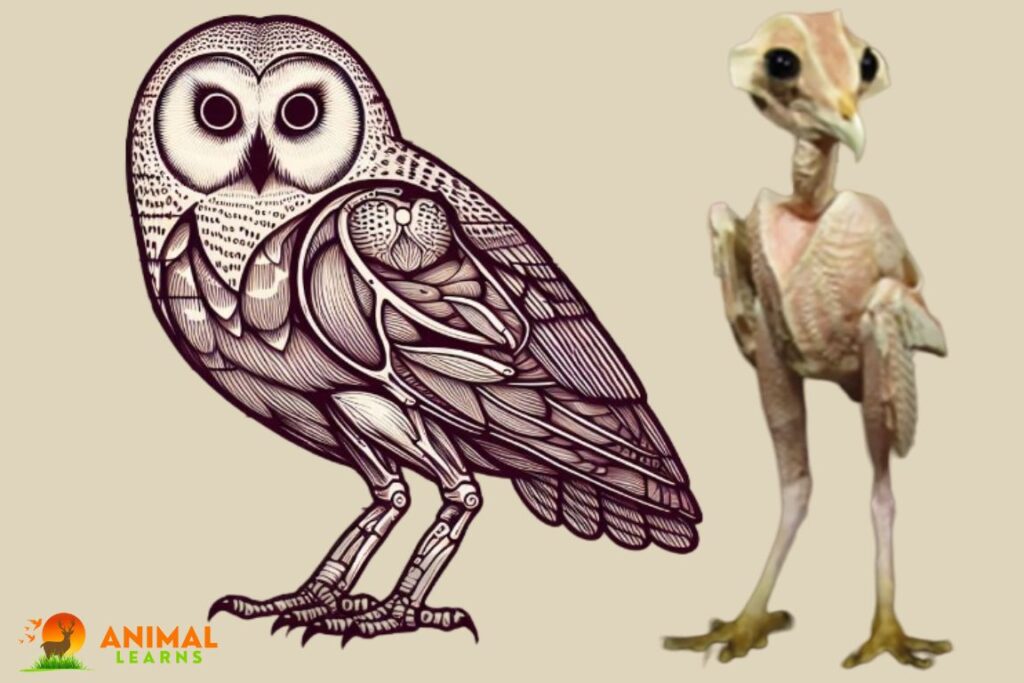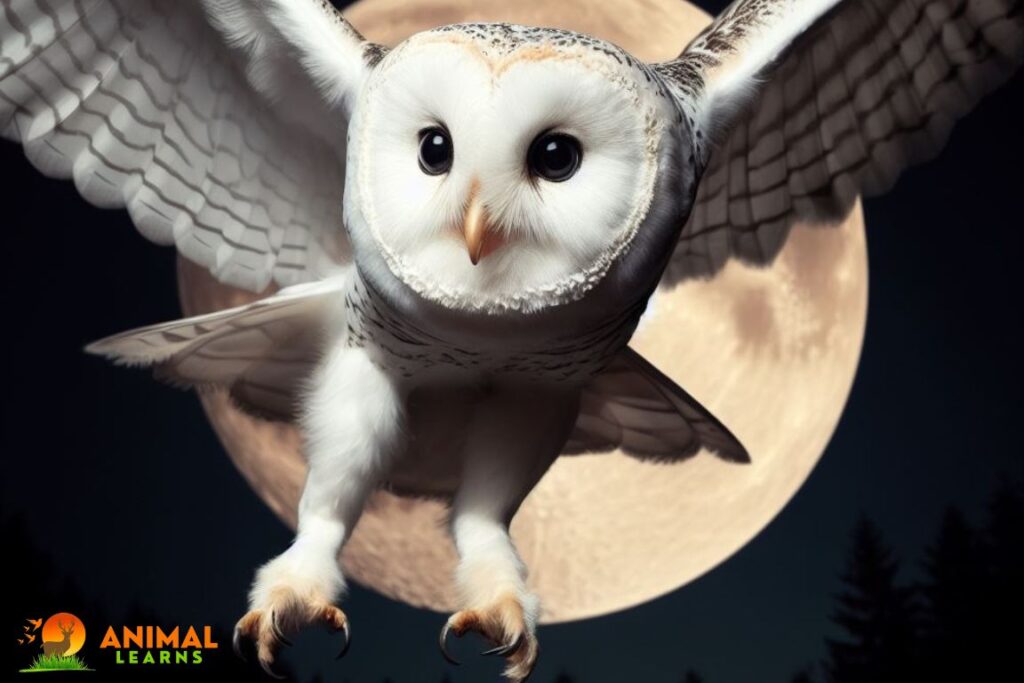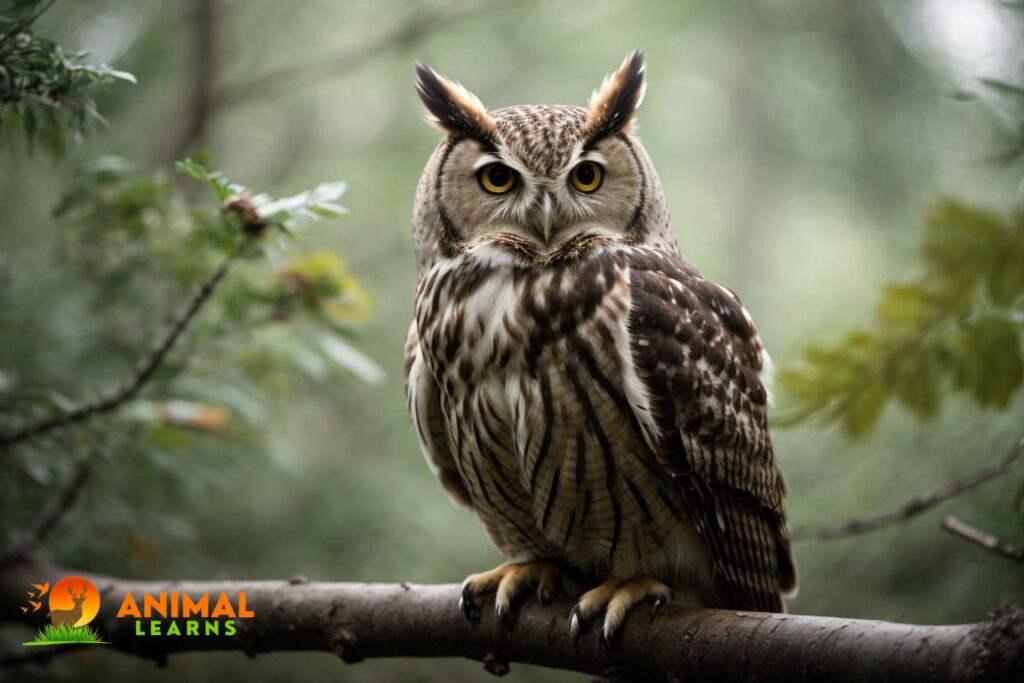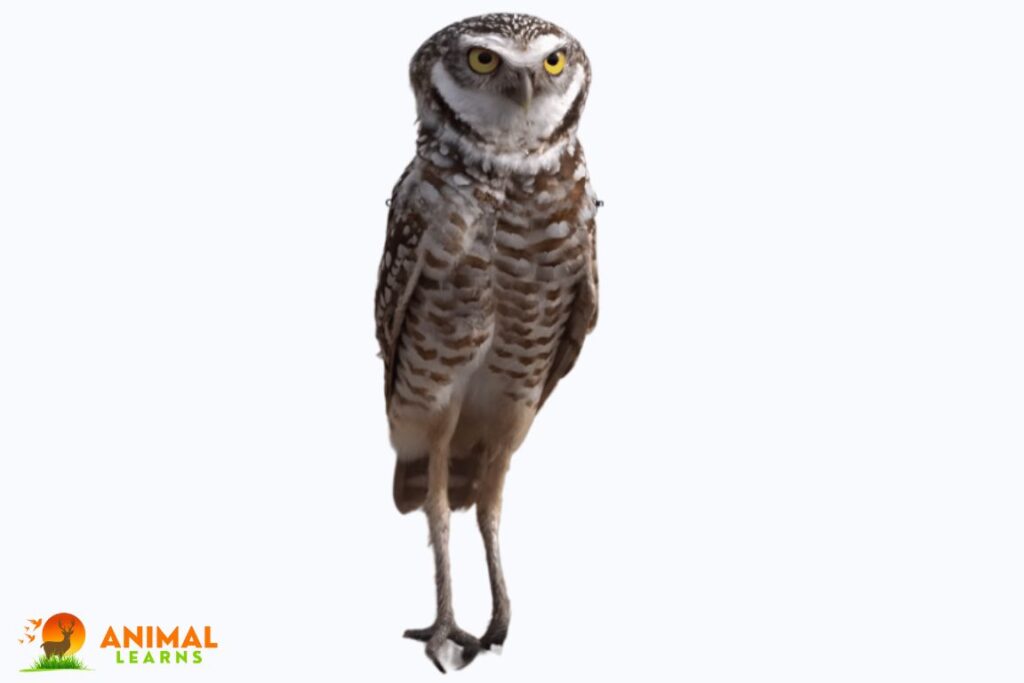Owl Legs: The Silent Predators Secret Weapon

| Attribute | Information |
|---|---|
| Scientific Name | Strigiformes |
| Size | Varies by species (15 cm to 70 cm) |
| Weight | Varies by species (50 g to 4 kg) |
| Color | Diverse range, often brown, gray, or white |
| Diet | Carnivorous, primarily small mammals and birds |
| Location | Worldwide, diverse habitats including forests, deserts, and urban areas |
“Beneath their feathers, owl legs are sturdy and built for nocturnal hunting, while their remarkable eyes and sharp talons remain a marvel of nature.”
Owls are mysterious birds of the night that can perform a variety of devious feats with great expertise. We talk a lot about their big eyes and quiet flying, but have you ever considered their legs? Owl legs are akin to a superpower with riddles that will soon be solved.
Numerous pictures of owl legs that have surfaced online over time have gained a lot of popularity and attention from people.
With more than 200 species worldwide, every owl species is distinct in terms of color, plumage pattern, and body shape—from the little Elf Owl to the imposing Great Grey Owl. Their strong legs and keen talons are still essential hunting equipment, despite their varied looks.
In spite of the fame of bandy-legged owl photos, they nonetheless attract a great deal of attention due to their mystery-filled legs. The next time you look at an owl, remember that beneath the fluffiness lies a set of legs that are perfectly adapted for nocturnal hunting.
Owl Leg Structure: A Closer Look
Contents
- 1 Owl Leg Structure: A Closer Look
- 2 What Do Owls Legs Look Like?
- 3 Owl Legs Length
- 4 Do Owls Have Legs?
- 5 The Anatomy Of Owl Legs
- 6 Do Owls Have Long Legs?
- 7 How Long Are Owl Legs?
- 8 Interesting Facts About Owl Legs
- 9 What Is The Reason For Owl Long Legs?
- 10 Why Are Owl Legs So Long?
- 11 What Do You Name The Legs Of An Owl?
- 12 Do Owls Have Feathered Legs?
- 13 Why Owl Long Legs Are Important?
- 14 Do Owl Long Legs Good For Flying?
- 15 Do Owls Have Knees?
- 16 Why Owl Legs Are Very Thin?
- 17 Do Owl Long Legs Good in Catching Prey?
- 18 Do Owls Walk?
- 19 Can Owls Run?
- 20 Can Owls Walk Backwards?
- 21 Why Owls Have Fluffy Legs
- 22 Myths and Symbolism
- 23 Owl Legs: A Comparison
- 24 Different Owl Species
- 25 What Type Of Feet Does An Owl Have?
- 26 Can Owls Sit Cross-Legged?
- 27 What Type Of Claw Does An Owl Have?
- 28 Do Owls Have Feet Or Legs?
- 29 How Do Owls Use Their Feet?
- 30 FAQs

Bones
Femur: The thigh bone of an owl is relatively short but powerful, giving them the strength needed for takeoff and flight.
Tibiotarsus: This is the long bone between the knee and the ankle. In owls, it fuses with the tarsometatarsus, forming a sturdy structure for landing and perching.
Tarsometatarsus: This is the lower leg bone, fusing with the tibiotarsus. The fusion provides stability and strength to support the owl’s body weight.
Tarsal Bones: These are the bones in the ankle region, that contribute to the overall stability of the leg.
Muscles
Flexor Muscles: These are responsible for the powerful grip of an owl’s talons. They contract when the owl catches prey, automatically locking the talons in place.
Extensor Muscles: These help in opening the talons and preparing for the next grab or landing.
Flight Muscles: While not directly related to the legs, the powerful breast muscles in owls are essential for flight. These muscles are robust enough to support the demands of nocturnal hunting.
Joints
Hinge Joint at the Knee: Allows for flexion and extension of the leg, providing the necessary movement for takeoff and landing.
Ball-and-Socket Joint at the Hip: Allows for a wide range of movement, aiding in the agility needed during flight.
Tendons
Tendon Locking Mechanism: Owls have a mechanism that automatically locks their talons in place when they grip onto something. This allows them to hold onto prey without actively exerting energy to keep their grip.
Feet
Zygodactyl Arrangement: The two toes facing forward and two backward give owls a versatile grip. The front toes secure the prey, while the rear toes act as a stabilizing anchor.
What Do Owls Legs Look Like?

Owl legs, often hidden beneath feathers, are adapted for nocturnal hunting. Long and slender, they are covered in fine feathers with cryptic coloration, aiding camouflage during the day.
The zygodactyl arrangement of toes—two forward, two backward—provides a powerful grip on prey and stable perching.
Razor-sharp talons at the tips showcase the precision essential for their hunting success. In essence, owl legs reflect an evolutionarily tuned fusion of form and function, enabling these birds to navigate the night with unparalleled skill.
Owl Legs Length
| Owl Species | Legs Length (cm) |
| Great Grey Owl | 20-28 |
| Snowy Owl | 15-18 |
| Barn Owl | 13-18 |
| Spectacled Owl | 13-15 |
| Great Horned Owl | 11-15 |
| Short-eared Owl | 10-12 |
| Northern Hawk Owl | 9-11 |
| Eastern Screech Owl | 8-12 |
| Elf Owl | 7-10 |
| Tawny Owl | 6-10 |
| Burrowing Owl | 6-8 |
Owl long legs, a marvel of evolution, trace their origins to the ancestral avian lineage. Shaped by selective pressures, these elongated limbs emerged as a brilliant solution for owls navigating the challenges of nocturnal hunting in low-light environments.
The survival implications are profound. Far beyond mere aesthetics, the extended legs are a strategic adaptation honed by natural selection.
Offering an elevated vantage point, these remarkable appendages empower owls with precision in surveying surroundings—essential for spotting prey and detecting potential threats in the shadows.
Moreover, the length of owls legs enhances their hunting prowess. Exhibiting grace and swiftness, these leggy avians use their extended reach to strike with unparalleled accuracy, a feat contributing to the sustained success of owl species over millennia.
Do Owls Have Legs?

There is no doubt that owls have legs. Their two feathered legs are located under their bodies, and they are used to walk, perch, and hunt. Owl legs are thin, lightweight, and feathered, allowing them to move quickly and quietly.
The Anatomy Of Owl Legs

Absolutely, owls indeed have legs! While we often marvel at their captivating eyes and silent flight, their legs are like hidden gems in the realm of avian anatomy. Delving into the intricacies of owl leg anatomy reveals a finely tuned biological marvel shaped by evolutionary forces.
Notably, their remarkable leg elongation is a testament to adaptive pressures. The skeletal structure, featuring an elongated tarsometatarsus and phalanges, grants owls an extended stride and formidable reach.
Enhanced by powerful talons, these legs facilitate precise prey capture. The joint arrangement enables swift and silent movement, a crucial asset in nocturnal hunting.
The plumage on owl legs, serving functional and aesthetic purposes, includes specialized feathers for insulation, ensuring optimal temperature regulation during cold nights. Overall, the anatomy of owl legs showcases evolutionary artistry, crafting consummate nocturnal predators.
Do Owls Have Long Legs?
Owls are famous, for their characteristics like their night vision, noiseless flight, and iconic hooting sounds. However, when it comes to legs they don’t exactly boast limbs. Actually, owls have legs compared to their body size.
This adaptation is vital for their hunting technique because shorter legs offer stability and balance when perched or diving down to capture prey. The focus for these birds of prey lies in their talons and impressive wingspan enabling them to be efficient hunters in the darkness of the night sky.
So even though their legs may not be the standout feature they play a role, in the stealth and precision that make owls formidable predators.
How Long Are Owl Legs?

When exploring the measurements of owl legs we uncover a world of adaptations that cater to their hunting needs. On average owl legs are relatively shorter compared to their body size. This compact build serves, as an advantage by providing stability during perching and agile pouncing on prey.
There are various species of owls, and their legs may vary in length from 6 cm to 30 cm. It is, however, possible to have legs as long as 38 cm (15 inches) in some of the larger owl species, such as the Great Grey Owl and the Eurasian Eagle Owl.
Interesting Facts About Owl Legs
- Talons: Owls have sharp claws, on their legs that assist them in catching and immobilizing their prey effectively.
- Zygodactyl Feet: Owls possess two toes pointing forward and two toes pointing backward which provide them with a grip on branches or when capturing their prey.
- Silent Flight Adaptations: Special feathers on the legs of owls help reduce noise during flight enabling them to hunt
- Feathered Legs: Certain owl species have feathers on their legs, which serve as insulation and camouflage.
- Muscles: Robust leg muscles enable owls to hunt and maintain a firm grip while flying.
- Variation in Leg Lengths: Different owl species adapt their leg lengths based on their hunting styles and the environments they inhabit.
- Nocturnal Adaptations: Owl legs play a role in hunting by complementing their keen vision with specialized feathers, for enhanced performance.
- Mobility: Despite their appearance owl legs offer flexibility allowing for movements as needed.
- Species Differences: Owl legs exhibit variations that reflect the habitats they occupy. The prey they prefer.
What Is The Reason For Owl Long Legs?
- Adaptation to hunting: A longer leg helps owls catch prey from a distance without alerting it with their bodies, thereby enhancing their hunting reach.
- Silent flight: Longer legs enable owls to fly silently by reducing noise caused by rustling leaves and movement on the ground.
- Versatility in prey capture: In response to changes in food availability, longer legs enable owls to catch a wider variety of prey.
- Improved visibility: The owl’s long legs have evolved longer, enabling it to sit higher and thus better see prey or predators from afar.
- Thermoregulation: During nocturnal activities, owls need to regulate their body temperature to survive, so longer legs help them elevate off the ground.
- Territorial advantage: As a result of long legs, owls are better able to cover more ground while protecting nest sites and hunting grounds in their territory.
Why Are Owl Legs So Long?

The predatory prowess of owls is the reason they have long legs. These extended limbs are important for nocturnal hunters, as they provide them with the ability to fly silently and swiftly.
Owls can perch at high elevations and survey their surroundings with sharp eyesight because of the length of their legs.
Furthermore, their leg length helps them maintain balance and stability during flight, allowing them to capture prey more accurately.
What Do You Name The Legs Of An Owl?
An owl’s legs are typically called “tarsi,” which are used to grasp and hold onto prey. Owls have strong tarsi that allow them to grasp and hold on to their prey. This combination of strong legs and sharp talons makes owls formidable predators in the dark.
Also, the tarsi are covered with specialized scales that provide additional protection as well as allow them to grip slippery or elusive prey.
Do Owls Have Feathered Legs?
There are scales on the legs of owls, similar to those of other birds of prey. Contrary to popular belief, they don’t have feathered legs. However, the dense feathers on their bodies often extend down to their tarsi bases, creating the illusion of feathered legs.
Their feathers serve as a means of streamlining their bodies during flight, reducing air resistance, and maintaining their body temperatures.
Why Owl Long Legs Are Important?
Discuss the ecological and biological importance of owl legs.
As predatory animals, owls have evolved legs that have powerful muscles and sharp talons that allow them to catch and hold prey, preventing escape during the night.
The unique feather structure ensures that owls can hunt silently and stalk prey even at night by minimizing sound during approach. This silent ability gives owls a significant advantage in hunting.
Through their efficient hunting, owls contribute to ecosystem balance by controlling rodent populations, thereby influencing biodiversity in their habitats.
As well as contributing to the intricate social dynamics of owl populations and ensuring successful reproduction, owl legs are utilized for communication with rivals and potential mates, contributing to the territorial and mating behaviors of owls.
Do Owl Long Legs Good For Flying?

There is no correlation between owl legs’ length and its ability to fly. Owls’ ability to fly is primarily determined by their wings and feathers. Owl legs provide balance and stability to their flight.
Owls extend their legs when landing or taking off so that they can stay balanced and adjust their position in the air. They may also be able to fly more efficiently due to the feathers on their legs and talons.
Do Owls Have Knees?
Owls do indeed have knees, but they are hidden beneath their feathery exteriors, so they are not visible to the outside world. Owls have a joint equivalent to the human knee.
As they navigate dense foliage in pursuit of prey, they can fly efficiently and noiselessly thanks to this adaptation, which contributes to their streamlined appearance and aerodynamic appearance.
Why Owl Legs Are Very Thin?

What Makes Owl Legs Thin? Owls are ambush predators, relying on stealth and surprise to catch their prey, which is why their legs are so thin. In order to succeed at nocturnal hunting, they need thin legs, which reduce air resistance, so they can move quickly and quietly.
Additionally, the thin legs provide the owl with maximum balance, allowing him to perch on branches without compromising the body’s balance.
Do Owl Long Legs Good in Catching Prey?
In addition to providing the distance needed to snatch prey from the ground or vegetation while the owl is in flight, owl long legs also assist in catching prey. The long legs of the owl contribute to its efficiency as a nighttime predator, helping it catch a meal.
Together with their exceptional vision and hearing, these long legs make them effective predators. They eat their catch as they return to their roost because their sharp talons prevent the prey from escaping.
Do Owls Walk?

The silent flight of owls is renowned, but it does not extend to walking. Unlike many terrestrial counterparts, owls don’t walk in a very graceful fashion.
The legs are rather long and the bodies are geared towards flight rather than leisurely strolling. They walk awkwardly, more functional than elegantly when they do.
Can Owls Run?
The strength of an owl lies in its ability to fly. It’s not their forte to run. Despite their ability to hop or move in short bursts, you won’t see an owl sprint.
The concept of an owl sprinting across the landscape is more of a whimsical thought than a reality because they use surprise aerial attacks rather than ground pursuits in their hunting prowess.
Can Owls Walk Backwards?
The owl’s talons are arranged in a unique way that allows the owl to walk both forward and backward. This structure gives the owl exceptional balance and enables him or her to walk in different directions quite easily.
Why Owls Have Fluffy Legs
Aside from making owls more visually appealing, their feathered legs also serve an important functional purpose: they provide insulation against the cold. This adaptation allows owls to maintain optimal body temperatures throughout the night.
Myths and Symbolism

Myths
The myth of the owl and the folklore surrounding it are deeply rooted in ancient Greece. Ancient Greeks associated owls with Athena, the goddess of wisdom, highlighting the owl as a symbol of intelligence.
Native American cultures, on the other hand, saw owls as ominous bearers of death, demonstrating the diversity in interpretation across cultures.
Symbolism
The nocturnal nature of these creatures, their keen eyesight, and their enigmatic presence make them timeless icons of wisdom. An owl is considered a guide through life’s mystical dimensions, possessing heightened insight in the realm of intuition.
A symbol of adaptability and resilience, owls gracefully navigate the unknown with skill, representing transition and change. Traditionally, owls represent stealth and secrecy through their silent flight, making them keepers of secret knowledge.
As a result of their nocturnal habits and haunting hoots, owls may be associated with death and the afterlife in some cultures. As natural predators and adaptive animals, owls are symbolically connected to transformation and regeneration in mythologies.
Owl Legs: A Comparison
Each owl has honed its legs to fit its ecological niche, which is revealed by analyzing the nuances of its leg characteristics. The Eagle Owl, for example, has very powerful legs, whereas the Saw-whet Owl has delicate limbs.
Different Owl Species

Barn Owl
This owl is excellent at hunting and has an outstanding sense of hearing. It is known for its heart-shaped facial discs.
Great Horned Owl
One of the most widespread and powerful owls in North America, the Great Horned Owl has distinctive tufts of feathers on its head.
Snowy Owl
Snowy owls are mostly associated with snowy landscapes. Known for their white plumage, they can survive in cold climates.
Elf Owl
In the southwestern United States and Mexico, elf owls are the smallest owls. They are about the size of a sparrow.
Burrowing Owl
Owls that burrow instead of nesting live in burrows. They are active during the day, unlike other species of owl.
Spectacled Owl
A Spectacled Owl is distinguished by the “spectacles” of white or light-colored feathers surrounding its eyes.
Eastern Screech Owl
Despite the name, Eastern Screech Owls don’t always screech. This species is found in eastern North America and comes in two color varieties, red and gray.
Northern Saw-whet Owl
These small and shy birds are known for their distinctive calls, which some say sound like a saw being sharpened. The Northern Saw-whet Owl is named after its distinctive call.
What Type Of Feet Does An Owl Have?

This arrangement gives owls a versatile and powerful grip, essential for hunting and capturing prey. Owl feet are zygodactyl, having two toes pointing forward and two toes pointing backward.
Can Owls Sit Cross-Legged?
It is not possible for owls to sit cross-legged because the structure of their joints prevents them from doing so. However, they can perch comfortably on branches or surfaces using their talons and feet.
What Type Of Claw Does An Owl Have?

An owl’s claws are made of powerful and sharp talons which are used for catching and securing prey. Their feet also feature an automatic locking mechanism which ensures that once they grasp something, they remain secure.
Do Owls Have Feet Or Legs?
The feet of owls are equipped with sharp talons that permit them to hunt and capture prey. The legs support the body and provide structural support. The feet are equipped with robust bones and joints to facilitate takeoff and landing.
How Do Owls Use Their Feet?

Owls use their feet for various purposes, primarily in hunting. The zygodactyl arrangement makes it easy for them to grasp prey.
Due to their automatic locking mechanisms in their talons, the nocturnal predators are as efficient as nocturnal predators because they require less effort to maintain a secure hold. Their feet also aid in balancing during flight and perching.
FAQs
How long are owl legs?
The length of an owl’s leg varies by species, ranging from 7 to 28 centimeters.
Why do owls have long legs?
During hunting, owls use their long legs to perch on branches and navigate different terrains.
Can owls hunt with their legs?
Probably, owl legs are designed to hunt; they have sharp talons for catching and grabbing prey.
What are the differences between owls and other bird legs?
Unlike other birds, owls have powerful legs covered in feathers that provide insulation and enhance their ability to fly silently.
Can owls move their legs independently?
Owls can move their heads without moving their bodies because their legs can rotate independently.
Do all owl species have the same leg length?
No, owl leg length varies between species and is influenced by their habitat and hunting styles.
How fast can owls run on their legs?
Owls are not fast runners; they rely on flight for hunting and escaping predators.
Are owl legs strong enough to carry their prey in flight?
Yes, owl legs are strong, and their talons can securely hold prey even while in flight.












